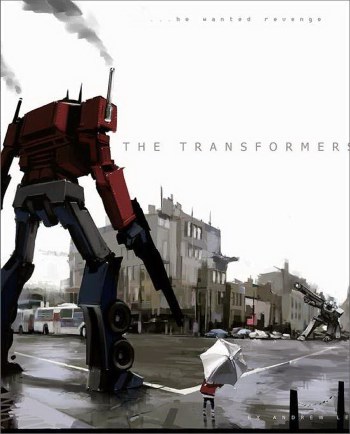Chapter 7: Acting with Transformers That Aren't Really There
 As visual effects become more sophisticated and computer-generated characters become more and more a part of mainstream films, the question remains: how does a real-life actor act when there's no one on the other end of the conversation? As visual effects become more sophisticated and computer-generated characters become more and more a part of mainstream films, the question remains: how does a real-life actor act when there's no one on the other end of the conversation?
“People ask me all the time how do you know when you're overacting,” says LaBeouf about his experience working on “Transformers,” “but how do you determine what overacting is when there's supposed to be a robot in your backyard? How can you be minimal about that?”
LaBeouf, Fox, and the other actors spent a good deal of their time craning their necks, looking at the top of an extension pole that could be lengthened to accommodate the height of any robot -- 20 feet for Bumblebee, 40 feet for Optimus, etc.
Sometimes the visual effects crew would tape a mask of the robot's likeness to the top or stick a tennis ball onto the end of the pole, but more often than not, the cardboard cutout fell off or the tennis ball was forgotten in a trailer on the other side of location and the actors were forced to keep their eyes on the bare end of the pole.
“You've got to be in love with that pole,” says LaBeouf. I asked Turturro and Voight about it. Where do you pull from? How do you find the right place to go? These guys are legends, so I thought they'd know how to do this, but they were just as lost. It's like soft dirt - you don't know exactly where to step. It's a completely different form of acting. But that's also where the fun comes in because Michael will give you the freedom to play for six or seven takes just to see what works.”
“Sometimes it was a little weird,” says Turturro about the makeshift robot stick. “And for some reason that's always the last thing anyone thinks about: where is the person, the image, the situation for the actor to react to? It's the difference between having another actor off camera or having no one there during those close ups, it can really make your performance. It really helped when Michael had the guy [actor and voice-over artist Mark Ryan] on set doing the austere voice, but you would think that someone would invent a giant animated puppet for the actors to work with, but even that would pale by comparison to the robots that the audience will eventually see in the film.”
Fox, who does not like watching her own performance, is looking forward to seeing the film if only to watch a scene in which Mikaela and Sam spend the entire sequence in conversation with a group of Autobots. “We were in an alley talking to nothing for three days,” recalls Fox. “It was just Shia and me talking to the sky. I'll watch that for sure.”
Tyrese Gibson agrees, “It's kind of wild, talking to robots that aren't there, but that's acting!” he says succinctly. “It's our job to make you believe that Superman or Megatron is coming down the street, even if we don't see him. It's all in a day's work.”
“The animatics that Michael would show us from time to time really helped to give me a point of reference,” says Anthony Anderson, “especially when you hadn't been on set in a few days. Michael enjoys showing people playback of scenes anyway, but he was great about having us watch the animatic or a piece of something the editors had cut so that we could get a grasp of what we were doing at any given point in the story.”
The comedian also points out that he is equally experienced at working opposite inanimate objects and animals. “Ever since working with a kangaroo, nothing seems too difficult,” he says. “Working with a tennis ball or a cardboard head on a pole doesn't seem so bad. I am the consummate professional,” he jokes.
LaBeouf also points out that his job was not simply memorizing dialogue, but memorizing movement and motivation as well. “I needed to break it down line by line,” explains. “I would say line 1, 2, 3 standing here, looking up. Then the robot is going to flip me over and jump here and I need to say line 4 and 5, and then he's moving here and he's going to have this emotion, so I will say line 6, 7, 8 in reaction and then move away from the robot so that he's behind me. It's a choreographed dance. It's difficult to maintain that continuity of character from scene to scene.
“My biggest concern was that the robots would be playing straight men to the actors,” he continues. “The acting was so extreme that ILM needed to match that intensity. They needed to think like an actor rather than just a technician or artist, or worse, a button pusher, and they did. I think the people at ILM did an incredible job.”
Michael Bay had his own taste of what it was like to direct actors and crew who weren't really there when he came down with a horrendous bout of flu during production. Determined not to leave the set and lose a day in the shooting schedule, Bay assigned Dave Deever, his video assist, to hook up a remote video / sound system that allowed him to rest in his trailer parked outside the stage while watching scenes and talking the cast and crew through every move. The experience gave him a brand new perspective.
|